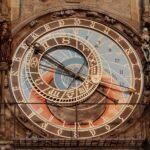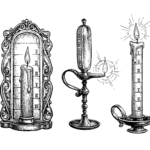 Today, we rely heavily on clocks. Almost everything we do happens on a time schedule. I used to joke that I couldn’t get away from them. There are watches, the clock on the stove or the walls of the house, my car, my computer at work, and later my ever-present phone. But what did people do before the invention of the clock as we know it today?
Today, we rely heavily on clocks. Almost everything we do happens on a time schedule. I used to joke that I couldn’t get away from them. There are watches, the clock on the stove or the walls of the house, my car, my computer at work, and later my ever-present phone. But what did people do before the invention of the clock as we know it today?
First, we must clear our heads of the modern concept of time and think not in hours and minutes but of moments, of repetitive divisions within our day. This is easier when talking about months; just follow the phases of the moon. But it becomes more complicated when you divide the time between sun up to sun up, or like the ancient Celts, sun down to sun down. Today, most watches display hours, minutes, and seconds.
Most of my research focuses on the early methods, but I will mention a few ‘improvements’ occurring over time. Some of it requires studying astronomy and other sciences of which most of us today have little knowledge.
 Even the earliest man would have noticed the passage of time. The sun rose, it set, and that process repeated. Most early civilizations believed it was because of their gods. One example is the early European Celts, who thought Bel (the sun god) rode his chariot across the sky. Certain everyday activities would be based on the sun’s position during the daylight hours. Watching the sun’s arc or the shadows are easy ways to track the day’s progression.
Even the earliest man would have noticed the passage of time. The sun rose, it set, and that process repeated. Most early civilizations believed it was because of their gods. One example is the early European Celts, who thought Bel (the sun god) rode his chariot across the sky. Certain everyday activities would be based on the sun’s position during the daylight hours. Watching the sun’s arc or the shadows are easy ways to track the day’s progression.
We’ll never know who the first person was to try to give structure to the day, but as early as 1500 BCE, the Egyptians had divided the daylight hours into twelve segments using the shadows on a sundial. We’ve all seen these, a flat surface with the increments etched into it. The vertical element casts its shadow on these as time moves forward. But of course, there is an obvious limitation to this method. What do you use on a rainy or cloudy day? Not to mention at night. A few centuries later, the Romans added a water clock which was calibrated to the sundial and allowed them continuous time measurement.
centuries later, the Romans added a water clock which was calibrated to the sundial and allowed them continuous time measurement.
Known as a clepsydra, this water clock was invented by the Greeks and used the flow of water to measure time. The divisions of the day were engraved on the inside of a bowl, and the slow and steady flow of the water indicated the passage of time. The Greeks used this device in another way; in court. Each side was given a certain amount of time to plead their case. When the bowl ran dry, the speaker was finished. Though, as you can imagine, it was not a very consistent method.
 While the candle clocks have been attributed to Alfred the Great, King of Wessex (871-889), the earliest mention of this method of time-keeping can be found in a poem written in 520 by a Chinese poet, You Jianfu. The Anglo-Saxon system consisted of six candles marked in one-inch intervals. Accuracy was reliant on the consistency of the wax and the dimensions of the candles.
While the candle clocks have been attributed to Alfred the Great, King of Wessex (871-889), the earliest mention of this method of time-keeping can be found in a poem written in 520 by a Chinese poet, You Jianfu. The Anglo-Saxon system consisted of six candles marked in one-inch intervals. Accuracy was reliant on the consistency of the wax and the dimensions of the candles.
In the mid-14th century, we see the rise of the hourglass in Europe, though they were most likely used at sea as early as the 11th century. Ferdinand Magellan used 18 hourglasses aboard each ship to aid in navigation during his circumnavigation of the globe in 1522. Due to improved glassblowing methods, they were quickly constructed and more reliable than previous methods.
 Over time, improvements were made, but medieval clocks still displayed the hours of the day until 1577, when Tycho Brahe, a Danish astronomer, developed clocks that measured in seconds. Quite the achievement!
Over time, improvements were made, but medieval clocks still displayed the hours of the day until 1577, when Tycho Brahe, a Danish astronomer, developed clocks that measured in seconds. Quite the achievement!
But the forerunner of our modern timepieces came from Galileo Galilei in 1582. As he watched the movement of a lamp suspended in the Cathedral of Pisa, he discovered a pendulum could be used as an accurate timepiece. After experimenting with his idea, he realized the swing was determined by the length. While he never developed this idea further, he did pass detailed instructions on to his son. The first pendulum clock was invented in 1656 by Christiaan Huygens. In the 17th and 18th centuries, the Jesuits contributed significantly to this idea. The accuracy of these erred by only a minute per day.

From this point onward, we see an explosion of ideas and improvements, too many (and too detailed) to cover here. However, researching this topic, which started with studying the early Celts in my local area, I discovered the following tidbit. I include it here because I find it fascinating, but I have not verified the material. You can find this, and more information at yddraig.com.
I knew the Celts measured time by the sun and moon and that the day began at sunset rather than at an arbitrary point in the middle of the night, as we do now.
Disappearance 1930-2230 (based on when the sun sets)
Midnight 2230-0130
Dawn 0130-0430
Morning 0430-0730
Mist-rise 0730-1030 (the author gets this from the translation of the Gaulish word anthert meaning the absence of vapor)
Midday 1030-1330
Rest 1330-1630
Dusk 1630-1930
Disappearance 1930-2230 (starts the next day)
I hope these are true as they are so representative of life. With being attacked an ever-present threat, these were the hours of the defensive watches. But they would probably also correspond to everyday activities within the tribe. The time increments indicated are modern.
Well, it’s nearly noon here now, and my stomach knows it’s time for lunch.
Who needs a clock?

Great article and information, thanks.
Thank you! I’m glad you enjoyed it.